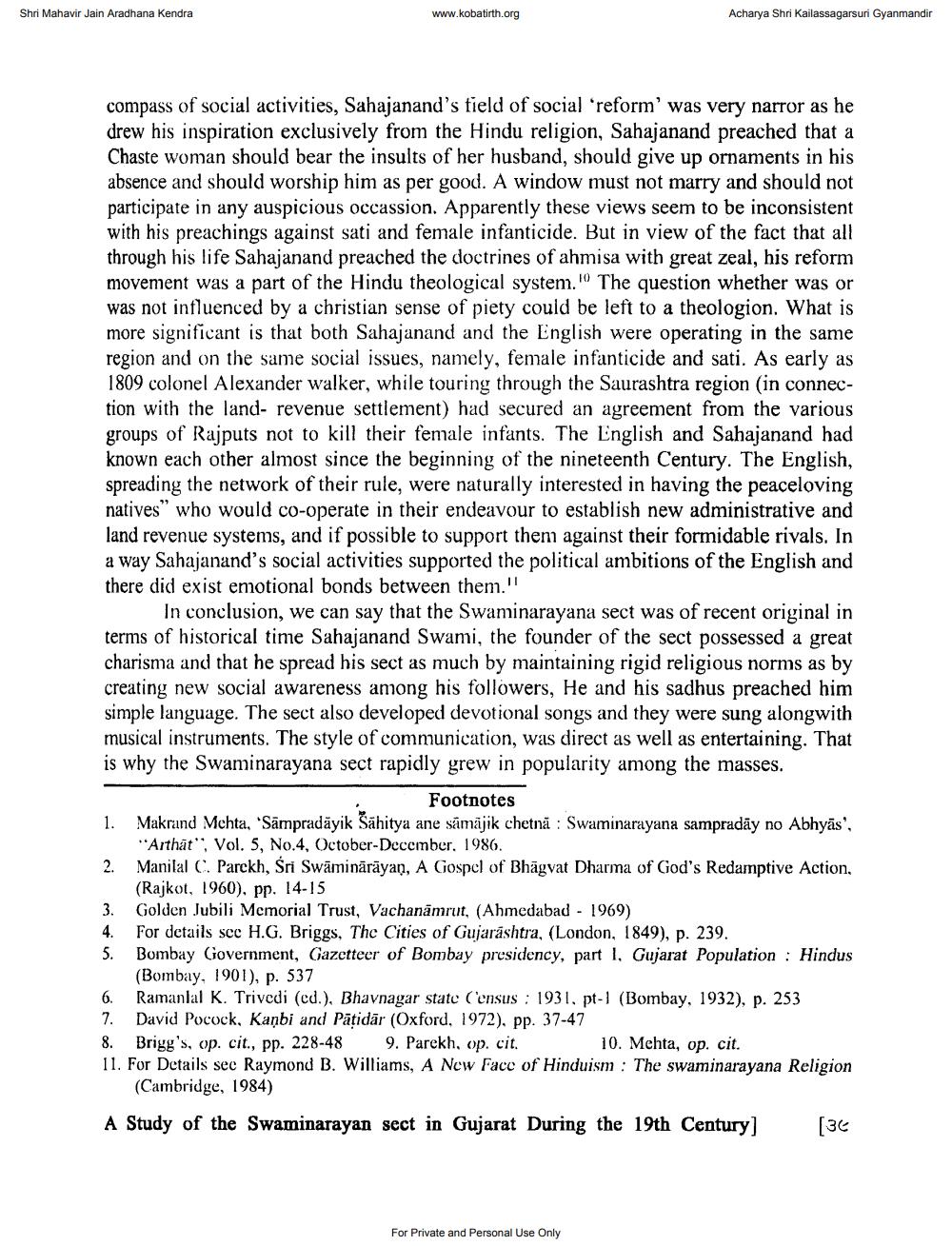________________
Shri Mahavir Jain Aradhana Kendra
www.kobatirth.org
compass of social activities, Sahajanand's field of social 'reform' was very narror as he drew his inspiration exclusively from the Hindu religion, Sahajanand preached that a Chaste woman should bear the insults of her husband, should give up ornaments in his absence and should worship him as per good. A window must not marry and should not participate in any auspicious occassion. Apparently these views seem to be inconsistent with his preachings against sati and female infanticide. But in view of the fact that all through his life Sahajanand preached the doctrines of ahmisa with great zeal, his reform movement was a part of the Hindu theological system. The question whether was or was not influenced by a christian sense of piety could be left to a theologion. What is more significant is that both Sahajanand and the English were operating in the same region and on the same social issues, namely, female infanticide and sati. As early as 1809 colonel Alexander walker, while touring through the Saurashtra region (in connection with the land- revenue settlement) had secured an agreement from the various groups of Rajputs not to kill their female infants. The English and Sahajanand had known each other almost since the beginning of the nineteenth Century. The English, spreading the network of their rule, were naturally interested in having the peaceloving natives" who would co-operate in their endeavour to establish new administrative and land revenue systems, and if possible to support them against their formidable rivals. In a way Sahajanand's social activities supported the political ambitions of the English and there did exist emotional bonds between them."
Acharya Shri Kailassagarsuri Gyanmandir
In conclusion, we can say that the Swaminarayana sect was of recent original in terms of historical time Sahajanand Swami, the founder of the sect possessed a great charisma and that he spread his sect as much by maintaining rigid religious norms as by creating new social awareness among his followers, He and his sadhus preached him simple language. The sect also developed devotional songs and they were sung alongwith musical instruments. The style of communication, was direct as well as entertaining. That is why the Swaminarayana sect rapidly grew in popularity among the masses.
3.
4.
Footnotes
1. Makrand Mehta, "Sampradayik Sahitya ane samajik chetnā: Swaminarayana sampraday no Abhyas",
"Arthat", Vol. 5, No.4, October-December. 1986.
Manilal C. Parekh, Sri Swaminārāyaṇ, A Gospel of Bhagvat Dharma of God's Redamptive Action, (Rajkot, 1960), pp. 14-15
Golden Jubili Memorial Trust, Vachanamrut, (Ahmedabad - 1969)
For details see H.G. Briggs, The Cities of Gujarashtra, (London, 1849), p. 239.
Bombay Government, Gazetteer of Bombay presidency, part 1. Gujarat Population: Hindus (Bombay, 1901), p. 537
Ramanlal K. Trivedi (ed.). Bhavnagar state Census: 1931, pt-1 (Bombay, 1932), p. 253
David Pocock. Kanbi and Pätidär (Oxford, 1972), pp. 37-47
6.
7.
8.
Brigg's, op. cit., pp. 228-48 9. Parekh, op. cit.
10. Mehta, op. cit.
11. For Details sec Raymond B. Williams, A New Face of Hinduism: The swaminarayana Religion (Cambridge, 1984)
A Study of the Swaminarayan sect in Gujarat During the 19th Century]
For Private and Personal Use Only
[૩૯




